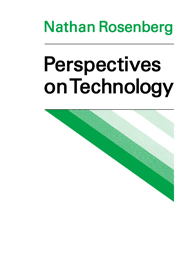Book contents
- Frontmatter
- Contents
- Acknowledgments
- Introduction
- Part 1 Some origins of American technology
- Part 2 The generation of new technologies
- Part 3 Diffusion and adaptation of technology
- 8 Capital goods, technology, and economic growt
- 9 Economic development and the transfer of technology: some historical perspectives
- 10 Selection and adaptation in the transfer of technology: steam and iron in America 1800-1870
- 11 Factors affecting the diffusion of technology
- Part 4 Natural resources, environment and the growth of knowledge
- Epilogue
- Notes
- Index
9 - Economic development and the transfer of technology: some historical perspectives
Published online by Cambridge University Press: 09 January 2010
- Frontmatter
- Contents
- Acknowledgments
- Introduction
- Part 1 Some origins of American technology
- Part 2 The generation of new technologies
- Part 3 Diffusion and adaptation of technology
- 8 Capital goods, technology, and economic growt
- 9 Economic development and the transfer of technology: some historical perspectives
- 10 Selection and adaptation in the transfer of technology: steam and iron in America 1800-1870
- 11 Factors affecting the diffusion of technology
- Part 4 Natural resources, environment and the growth of knowledge
- Epilogue
- Notes
- Index
Summary
Back in an earlier, more naive day, we managed to allow ourselves to believe that there was a purely technological solution – a cheap “technological fix” – to the problems of poverty and economic backwardness which beset most of the human race. In the Point Four of his 1949 inaugural address President Truman spoke optimistically of the incalculable benefits which technical assistance could bring to improving the desperate plight of the poor throughout the world. “We must embark,” he said, “on a bold new program for making the benefits of our scientific advances and industrial progress available for the improvement and growth of underdeveloped areas.”
Unfortunately we exaggerated from the outset what could be accomplished solely by making Western techniques available. In some measure the present mood of disillusion with foreign aid in general is due to the unrealistically high expectations which we once attached to such programs (including their effectiveness as weapons of politics and diplomacy). We now realize that there are a host of difficulties – institutional and otherwise – which hamper the successful adoption of foreign technology. I would like to contribute some observations of my own on the obstacles in the way of a successful transfer of technology. I will also, before I am done, go one pessimistic step further, and suggest that there are serious problems, not just in facilitating the transfer but in the very nature of technology which we presently have to offer and its possibly limited relevance (especially in agriculture) to the problems of poor countries.
- Type
- Chapter
- Information
- Perspectives on Technology , pp. 151 - 172Publisher: Cambridge University PressPrint publication year: 1976



